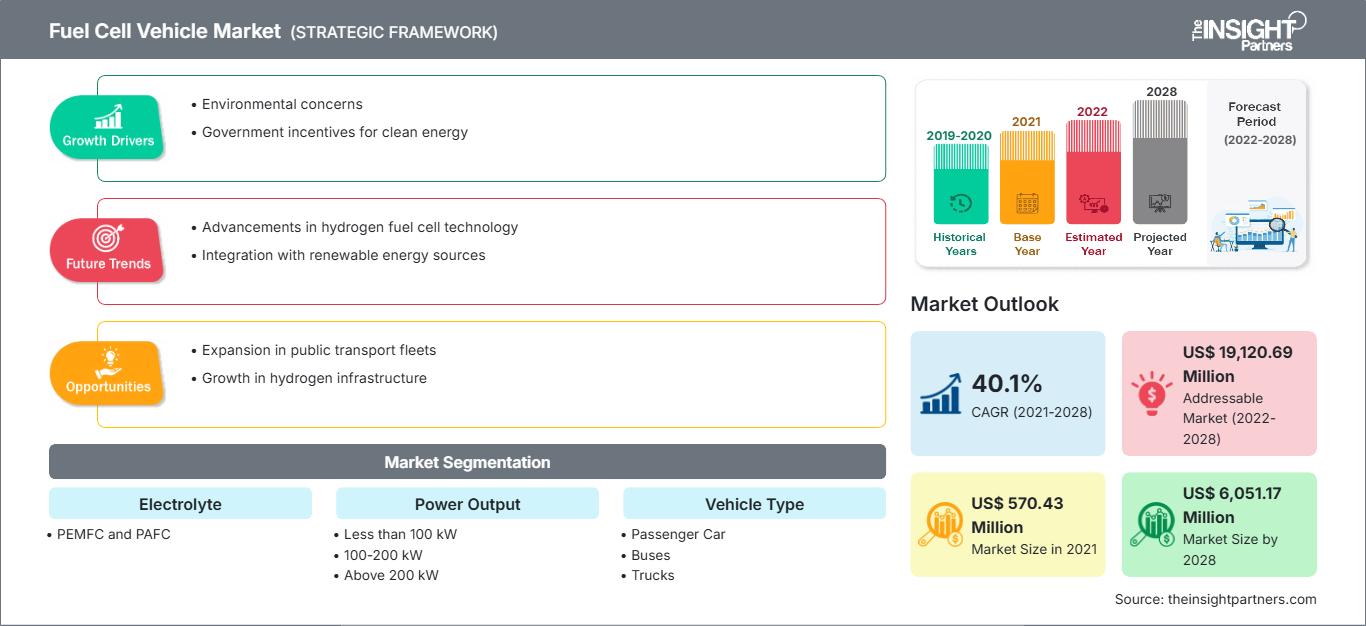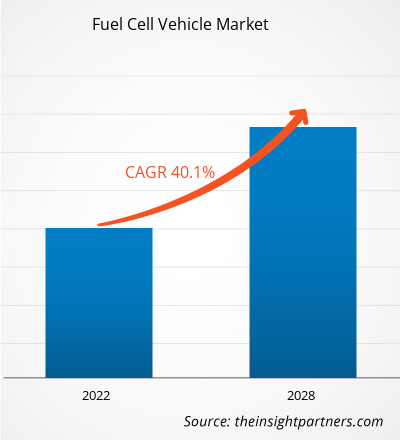[調査レポート] 燃料電池自動車市場は、2021年の5億7,043万米ドルから2028年には60億5,117万米ドルに達すると予測されており、2021年から2028年にかけて40.1%のCAGRを記録すると推定されています。
アナリストの視点:
近年、燃料電池自動車市場は、従来のガソリン車の有望な代替手段として大きな注目と勢いを増しています。燃料電池自動車(FCV)は、水素と酸素の化学反応によって電気を誘導し、水蒸気のみを排出する水素燃料電池によって駆動されます。FCVの主な利点の1つは、環境に優しいことです。水蒸気のみを排出するため、温室効果ガスの排出量と大気汚染の削減に貢献し、気候変動と都市の汚染という世界的な懸念に対処します。この特性により、燃料電池技術の採用と開発に対する政府の支援とインセンティブが増加しています。市場の成長に関しては、燃料電池車市場は着実な成長を遂げています。
自動車メーカーとテクノロジー企業は、燃料電池車の効率、性能、そして価格設定の改善を目指し、研究開発に多額の投資を行ってきました。その結果、FCVの航続距離は大幅に伸び、当初懸念されていた航続距離の限界が解消されました。燃料電池車市場は、従来の内燃機関車や電気自動車に比べるとまだ比較的小規模ですが、今後数年間で大幅な成長が見込まれています。持続可能な輸送ソリューションへの需要の高まりと、燃料電池技術およびインフラ整備の進歩が相まって、市場の拡大を牽引すると考えられます。さらに、自動車メーカー、エネルギー会社、政府間の提携や協力関係も、燃料電池車市場の成長を促進しています。これらの提携は、燃料電池車の普及を加速させ、研究開発を促進することを目的としています。
市場概要:
燃料電池車市場は、水素を燃料源として発電する燃料電池技術を搭載した車両に焦点を当てています。環境への懸念の高まりと持続可能な輸送手段へのニーズにより、市場は著しい成長を遂げています。政府の規制とインセンティブは、燃料電池車の普及促進において重要な役割を果たしてきました。燃料電池技術の進歩、業界関係者間の連携、そして継続的な研究開発の取り組みは、市場の拡大をさらに加速させています。高コストやインフラの不足といった課題は依然として残っていますが、技術の進歩とよりクリーンな輸送ソリューションへの需要の高まりに伴い、市場は将来的に大きな成長の可能性を秘めています。
要件に合わせてレポートをカスタマイズ
レポートの一部、国レベルの分析、Excelデータパックなどを含め、スタートアップ&大学向けに特別オファーや割引もご利用いただけます(無償)
燃料電池自動車市場: 戦略的洞察

- このレポートの主要な市場動向を入手してください。この無料サンプルには、市場動向から見積もりや予測に至るまでのデータ分析が含まれます。
市場の牽引役:環境問題への関心の高まりが燃料電池自動車市場の成長を牽引
レポートの一部、国レベルの分析、Excelデータパックなどを含め、スタートアップ&大学向けに特別オファーや割引もご利用いただけます(無償)
燃料電池自動車市場: 戦略的洞察

- このレポートの主要な市場動向を入手してください。この無料サンプルには、市場動向から見積もりや予測に至るまでのデータ分析が含まれます。
環境問題への関心の高まりは、燃料電池自動車市場の成長における重要な牽引役として浮上しています。従来のガソリン車が環境に与える有害な影響に対する人々の意識が高まるにつれ、よりクリーンで環境に優しい代替交通手段への需要が高まっています。こうした環境意識の高まりが、燃料電池自動車にとって好ましい市場環境を作り出しています。燃料電池自動車は、豊富でクリーンなエネルギーキャリアである水素を燃料源として利用します。燃料電池内で水素が酸素と混合されると電気が生成され、副産物として水蒸気が残ります。この排出ガスのない運転は、環境意識の高い消費者を引き付ける重要な要素です。大気汚染と温室効果ガス排出に対する意識の高まりにより、政府や規制当局はより厳しい環境規制を課しています。多くの国や地域が、炭素排出量を削減し、持続可能な輸送を促進するための野心的な目標を設定しています。これに対応して、自動車メーカーは、これらの規制を満たし、環境意識の高い顧客層にアピールするため、ポートフォリオの一部として燃料電池車の開発にますます注力しています。
さらに、燃料電池技術の進歩は、燃料電池車の性能と効率性を大幅に向上させました。これらの車両は現在、より長い航続距離とより短い燃料補給時間を実現しており、日常使用においてより実用的になっています。水素燃料補給ステーションのインフラの拡大も、燃料電池車の導入に伴う主要な課題の1つに対処することで、燃料電池車の市場成長を支えています。さらに、自動車メーカー、エネルギー会社、政府による燃料電池技術への投資と研究活動の増加は、燃料電池車の開発と商業化を加速させています。これらの投資は、燃料電池の技術的能力を向上させるだけでなく、生産コストの削減にも貢献し、市場における競争力を高めています。
セグメント分析:
車両タイプに基づいて、燃料電池車市場は乗用車、バス、トラック、小型商用車に分類されます。乗用車セグメントは2020年に最大の市場シェアを占め、予測期間中に市場で最高のCAGRを記録すると予測されています。乗用車セグメントは、さまざまな要因により、燃料電池車市場で最大のシェアを獲得しました。二酸化炭素排出量の削減と持続可能な輸送手段への移行に対する世界的な関心の高まりにより、燃料電池車の需要が高まっています。自動車メーカーは、燃料電池乗用車の開発と商品化に投資し、効率、航続距離、手頃な価格を改善してきました。
幅広い燃料電池乗用車モデルの提供、水素インフラの進歩、そして長い走行距離や燃料補給時間の短縮など、燃料電池技術の利点が、このセグメントの成功に貢献しています。全体として、乗用車セグメントは、自動車業界で燃料電池技術がますます受け入れられ、実現可能になっていることを反映しています。
地域分析:
アジア太平洋地域の燃料電池自動車市場は、2021年に3億169万米ドルと評価され、2028年には41億1,390万米ドルに達すると予測されています。予測期間中、年平均成長率(CAGR)45.2%で成長すると見込まれています。アジア太平洋地域は、燃料電池自動車市場における支配的な勢力として浮上しています。人口が多く、急速に都市化が進み、汚染や気候変動への懸念が高まるこの地域では、よりクリーンで持続可能な代替交通手段が積極的に採用されています。この地域の優位性に貢献している主な要因の1つは、燃料電池自動車の導入を促進する政府の強力な支援と政策です。日本、韓国、中国などの国では、燃料電池自動車の使用を促進するために、有利な規制、税制優遇措置、補助金などを実施しています。これらの措置により、メーカー、投資家、そして消費者のそれぞれにとって好ましい環境が整えられ、市場の成長が促進されました。特に日本は、燃料電池自動車の開発と普及において最前線に立っています。日本政府は、全国に水素ステーション網を整備することを目指し、水素インフラ整備に関して野心的な目標を設定しています。
さらに、トヨタやホンダといった日本の大手自動車メーカーは、燃料電池自動車の研究開発に多額の投資を行い、トヨタ・ミライやホンダ・クラリティといったモデルの商品化につながっています。韓国も燃料電池自動車市場で目覚ましい進歩を遂げています。政府は水素インフラ整備を優先課題とし、燃料電池バスや商用車の普及を積極的に支援しています。韓国に拠点を置くヒュンダイやキアといった企業は、ヒュンダイ・ネクソやキア・ニロといった革新的なモデルを通じて、燃料電池自動車の普及促進に大きく貢献してきました。人口が多く、大気汚染への懸念が高まる中国も、燃料電池自動車の可能性を認識しています。中国政府は、自国を水素技術の世界的リーダーとして確立するため、燃料電池車の生産に対して手厚い補助金と目標を導入しました。BYD、BAIC、Geelyなど、いくつかの中国の自動車メーカーは、燃料電池車の開発に多額の投資を行っており、この地域の市場全体の優位性に貢献しています。さらに、アジア太平洋地域は、強力な製造能力と技術的専門知識の恩恵を受けています。確立された自動車メーカーの存在と堅牢なサプライチェーンが、燃料電池車の生産と商品化を促進しました。さらに、この地域は高度な研究開発センター、学術機関、産学連携を誇り、燃料電池技術の技術的進歩を推進しています。
主要プレーヤーの分析:
燃料電池車市場分析は、現代自動車、トヨタ自動車、カミンズ、ゼネラルモーターズ、ABボルボ、本田技研工業、リバーシンプル、ハイゾンモーターズ、ダイムラーAGなどのプレーヤーで構成されています。燃料電池自動車分野では、Cummins Inc と Hyundai Motor Company が多様な製品ポートフォリオを提供していることから主要プレーヤーとして挙げられます。
燃料電池自動車市場の地域別分析
予測期間を通じて燃料電池自動車市場に影響を与える地域的な動向と要因については、The Insight Partnersのアナリストが詳細に解説しています。このセクションでは、北米、ヨーロッパ、アジア太平洋、中東・アフリカ、中南米における燃料電池自動車市場のセグメントと地域についても解説しています。
燃料電池自動車市場レポートの範囲
| レポート属性 | 詳細 |
|---|---|
| の市場規模 2021 | US$ 570.43 Million |
| 市場規模別 2028 | US$ 6,051.17 Million |
| 世界的なCAGR (2021 - 2028) | 40.1% |
| 過去データ | 2019-2020 |
| 予測期間 | 2022-2028 |
| 対象セグメント |
By 電解質
|
| 対象地域と国 | 北米
|
| 市場リーダーと主要企業の概要 |
|
燃料電池自動車市場のプレーヤー密度:ビジネスダイナミクスへの影響を理解する
燃料電池自動車市場は、消費者の嗜好の変化、技術の進歩、製品の利点に対する認知度の高まりといった要因により、エンドユーザーの需要が高まり、急速に成長しています。需要が高まるにつれ、企業は製品ラインナップの拡充、消費者ニーズへの対応、そして新たなトレンドの活用を進めており、これが市場の成長をさらに加速させています。

- 入手 燃料電池自動車市場 主要プレーヤーの概要
燃料電池車市場では、合併や買収といった無機的・有機的な戦略が企業に広く採用されています。最近の主要な市場動向をいくつか以下に挙げます。
- 2021年4月、SAFRA Materiel Transport PublicとSymbio(ミシュランとフォルシアの子会社)は、1,500台の水素バスを製造する契約を締結しました。
- 2020年12月、トヨタは新型車「ミライ」を発売しました。この車は、水素を燃料とする燃料電池で走行します。トヨタ・ミライは142.2リットルの燃料タンクを搭載し、燃料電池は最高出力171馬力、最大トルク221Nmを発揮します。
- 過去2年間の分析、基準年、CAGRによる予測(7年間)
- PEST分析とSWOT分析
- 市場規模価値/数量 - 世界、地域、国
- 業界と競争環境
- Excel データセット
最新レポート
関連レポート
お客様の声
購入理由
- 情報に基づいた意思決定
- 市場動向の理解
- 競合分析
- 顧客インサイト
- 市場予測
- リスク軽減
- 戦略計画
- 投資の正当性
- 新興市場の特定
- マーケティング戦略の強化
- 業務効率の向上
- 規制動向への対応




















 無料サンプルを入手 - 燃料電池自動車市場
無料サンプルを入手 - 燃料電池自動車市場